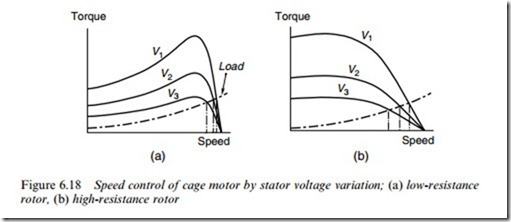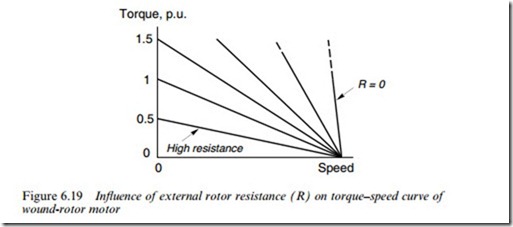SPEED CONTROL
We have seen that to operate eYciently an induction motor must run with a small slip. It follows that any eYcient method of speed control must be based on varying the synchronous speed of the Weld, rather than
the slip. The two factors that determine the speed of the Weld, are the supply frequency and the pole number (see equation (5.1)).
The pole number has to be an even integer, so where continuously adjustable speed control over a wide range is called for, the best approach is to provide a variable-frequency supply. This method is very important, and is discussed in Chapter 8. In this chapter we are concerned with constant frequency mains operation, so we have a choice between pole-changing, which can provide discrete speeds only, or slip control which can provide continuous speed control, but is inherently ineYcient.
Pole-changing motors
For some applications continuous speed control may be an unnecessary luxury, and it may be suYcient to be able to run at two discrete speeds. Among many instances where this can be acceptable and economic are pumps, lifts and hoists, fans and some machine tool drives.
We established in Chapter 5 that the pole number of the Weld was determined by the layout and interconnection of the stator coils, and that once the winding has been designed, and the frequency speciWed, the synchronous speed of the Weld is Wxed. If we wanted to make a motor, that could run at either of two diVerent speeds, we could construct it with two separate stator windings (say 4-pole and 6-pole), and energise the appropriate one. There is no need to change the cage rotor since the pattern of induced currents can readily adapt to suit the stator pole number. Early 2-speed motors did have 2 distinct stator windings, but were bulky and ineYcient.
It was soon realised that if half of the phase belts within each phase- winding could be reversed in polarity, the eVective pole number could be halved. For example, a 4-pole MMF pattern (N-S-N-S) would become (N-N-S-S), i.e. eVectively a 2-pole pattern with one large N pole and one large S pole. By bringing out six leads instead of three, and providing switching contactors to eVect the reversal, two discrete speeds in the ratio 2:1 are therefore possible from a single winding. The performance at the high (e.g. 2-pole) speed is relatively poor, which is not surprising in view of the fact that the winding was originally optimised for 4-pole operation.
It was not until the advent of the more sophisticated pole amplitude modulation (PAM) method in the 1960s that 2-speed single-winding high-performance motors with more or less any ratio of speeds became available from manufacturers. This subtle technique allows close ratios such as 4/6, 6/8, 8/10 or wide ratios such as 2/24 to be achieved. Close ratios are used in pumps and fans, while wide ratios are used for example in washing machines where a fast spin is called for.
The beauty of the PAM method is that it is not expensive. The stator winding has more leads brought out, and the coils are connected to form non-uniform phase belts, but otherwise construction is the same as for a single-speed motor. Typically six leads will be needed, three of which are supplied for one speed, and three for the other, the switching being done by contactors. The method of connection (star or delta) and the number of parallel paths within the winding are arranged so that the air-gap Xux at each speed matches the load requirement. For example, if constant torque is needed at both speeds, the Xux needs to be made the same, whereas if reduced torque is acceptable at the higher speed the Xux can obviously be lower.
Voltage control of high-resistance cage motors
Where eYciency is not of paramount importance, the torque (and hence the running speed) of a cage motor can be controlled simply by altering the supply voltage. The torque at any slip is approximately proportional to the square of the voltage, so we can reduce the speed of the load by reducing the voltage. The method is not suitable for standard low-resist- ance cage motors, because their stable operating speed range is very restricted, as shown in Figure 6.18(a) . But if special high-rotor resistance motors are used, the slope of the torque–speed curve in the stable region is much less, and a rather wider range of steady-state operating speeds is available, as shown in Figure 6.18(b).
The most unattractive feature of this method is the low eYciency, which is inherent in any form of slip control. We recall that the rotor eYciency at slip s is (1 – s), so if we run at say 70% of synchronous speed (i.e. s ¼ 0:3), 30% of the power crossing the air-gap is wasted as heat in the rotor conductors. The approach is therefore only practicable where the load torque is low at low speeds, so that at high slips the heat in the rotor is tolerable. A fan-type characteristic is suitable, as shown in Figure 6.18(b),
and many ventilating systems therefore use voltage control.
Voltage control became feasible only when relatively cheap thyristor
voltage regulators arrived on the scene during the 1970s. Previ- ously the cost of autotransformers or induction regulators to obtain the variable voltage supply was simply too high. The thyristor hardware required is essentially the same as discussed earlier for soft starting, and a single piece of kit can therefore serve for both starting and speed control. Where accurate speed control is needed, a tachogenerator must be Wtted to the motor to provide a speed feedback signal, and this naturally increases the cost signiWcantly.
Applications are numerous, mainly in the range 0.5–10 kW, with most motor manufacturers oVering high-resistance motors speciWcally for use with thyristor regulators.
Speed control of wound-rotor motors
The fact that the rotor resistance can be varied easily allows us to control the slip from the rotor side, with the stator supply voltage and frequency constant. Although the method is inherently ineYcient it is still used in many medium and large drives such as hoists, conveyors and crushers because of its simplicity and comparatively low cost.
A set of torque–speed characteristics is shown in Figure 6.19, from which it should be clear that by appropriate selection of the rotor circuit resistance, any torque up to typically 1.5 times full-load torque can be achieved at any speed.


